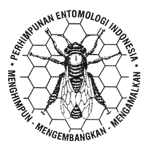Perkembangan dan Kandungan Nutrisi Larva Hermetia illucens (Linnaeus) (Diptera: Stratiomyidae) pada Bungkil Kelapa Sawit
DOI:
https://doi.org/10.5994/jei.7.1.28Keywords:
Hermetia illucens, development, PKM, proximate analysisAbstract
Hermetia illucens, is used as a reducing agent of palm kernel meal (PKM), as well as one of alternative protein sources for aquaculture purposes. Information about biology of H. illucens is absolutely required in mass production. The objectives of these researches were to study the development of H. illucens including the effect of supplementary food to the adult, and nutrient content of the immature stage. The sample of 20 larvae from each 3 replicates were measured and weighed on 0-19th day (larva) and 24th day (pupa) from egg hatching. H. illucens adults were fed by water and honey 5% (v/v). Eggs were collected and counted. Nutrient content of immature stage: 5, 10, 15, 20 days old (larvae), and 25 days old (prepupae) reared on PKM were analyzed proximately. Dry matter was determined by weight loss on drying at 105 oC during overnight. Crude protein was determined by Kjeldahl procedure (N x 6.25), crude fat by soxhlet (ether extract), crude ash by determining the residue after heating at 550 oC for 4–5 h. Data were analyzed descriptively by average from triplicate. The development of H. illucens was shorter than those in previous studies as the differences of abiotical factor. PKM was a suitable medium for development. It was better, however, to fed the adult with honey since it could enhance the fecundity. The young larva certainly contained the best quality of nutrition. To meet the quantity of mass production, however, the use of the elder larva (bigger) was suggested.Downloads
Download data is not yet available.
Downloads
Published
2015-09-28
How to Cite
RACHMAWATI, R., BUCHORI, D., HIDAYAT, P., HEM, S., & FAHMI, M. R. (2015). Perkembangan dan Kandungan Nutrisi Larva Hermetia illucens (Linnaeus) (Diptera: Stratiomyidae) pada Bungkil Kelapa Sawit. Jurnal Entomologi Indonesia, 7(1), 28. https://doi.org/10.5994/jei.7.1.28
Issue
Section
Articles
License
Authors who publish with this journal agree to the following terms:
- Authors retain copyright and grant the journal right of first publication with the work simultaneously licensed under a Creative Commons Attribution 4.0 International License that allows others to share the work with an acknowledgement of the work's authorship and initial publication in this journal.
- Authors are able to enter into separate, additional contractual arrangements for the non-exclusive distribution of the journal's published version of the work (e.g., post it to an institutional repository or publish it in a book), with an acknowledgement of its initial publication in this journal.
- Authors are permitted and encouraged to post their work online (e.g., in institutional repositories or on their website) prior to and during the submission process, as it can lead to productive exchanges, as well as earlier and greater citation of published work (See The Effect of Open Access).








